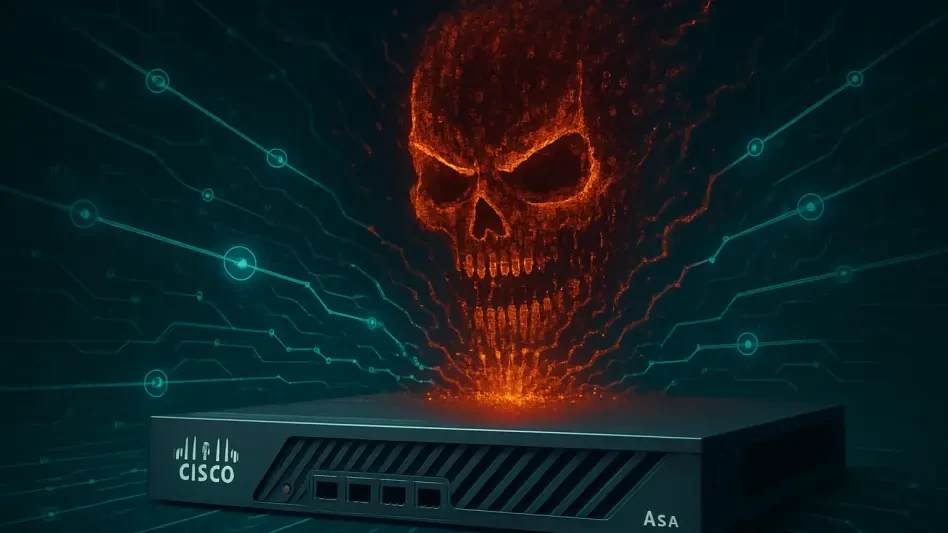In a startling development that has sent ripples through the cybersecurity community, a dramatic surge in scanning activity targeting Cisco Adaptive Security Appliance (ASA) devices has raised alarms about potential vulnerabilities and impending cyber threats. Late last year, security intelligence providers detected two significant spikes in reconnaissance efforts aimed at these critical network security systems, with activity levels soaring far beyond normal baselines. These events, characterized by tens of thousands of unique source IPs probing for weaknesses, suggest a coordinated campaign that could precede the disclosure of new exploits. As organizations worldwide rely on Cisco ASA devices to safeguard their networks, this uptick in malicious activity underscores the urgent need for heightened vigilance and robust defensive measures. The implications of such large-scale scanning are profound, hinting at sophisticated actors preparing to exploit exposed systems and highlighting the ever-evolving nature of cyber risks in today’s digital landscape.
Unveiling the Scale of the Scanning Activity
The sheer magnitude of the scanning surge targeting Cisco ASA devices is staggering, with over 25,000 unique source IPs recorded during the first major spike late last year, followed by a second, slightly smaller wave shortly after. Under typical conditions, daily scans against these devices hover below 500 IPs, making the sudden escalation a glaring anomaly. Security intelligence data reveals that more than 80 percent of the IPs involved in the initial burst shared identical technical signatures, pointing to a highly organized botnet operation rather than disparate, random scans. The focus was predominantly on ASA web login paths, a known weak point for attackers seeking unauthorized access. This level of coordination suggests that the perpetrators are not merely opportunistic but are likely part of a deliberate effort to map out vulnerable systems for future exploitation, raising concerns about the potential scale of damage if these scans translate into active attacks.
Beyond the raw numbers, the geographical patterns of this activity provide further insight into the nature of the threat. A striking 64 percent of the scanning traffic originated from Brazil, with smaller but notable contributions from Argentina and the United States. Meanwhile, the targets were overwhelmingly located in the United States, accounting for 97 percent of the scanned systems, alongside minor activity in the United Kingdom and Germany. The consistency in tools and methods across both spikes—evidenced by shared spoofed user-agents mimicking legitimate browsers—indicates a unified toolkit deployed by the attackers. This geographical concentration, paired with the technical uniformity, paints a picture of a sophisticated campaign that transcends borders, targeting critical infrastructure in specific regions while leveraging a centralized base of operations to maximize efficiency and impact.
Potential Implications of the Scanning Surge
The timing and intensity of these scanning events carry ominous implications, particularly when viewed through the lens of historical patterns in cybersecurity. Research into early warning signals suggests that such reconnaissance bursts often precede the public disclosure of new vulnerabilities, known as Common Vulnerabilities and Exposures (CVEs), for the targeted technology. Past instances of similar activity targeting Cisco ASA devices have frequently been followed by zero-day exploit announcements, leaving organizations with little time to react before attacks commence. The late-year surge could very well be a harbinger of an undisclosed flaw in ASA systems, prompting speculation about the nature and severity of potential exploits. If history is any guide, the window for preparation is narrow, and the risk of rapid weaponization by malicious actors—ranging from state-sponsored groups to ransomware operators—is alarmingly high.
Real-world examples amplify the urgency of this situation, as Cisco ASA devices have previously been prime targets for high-profile attacks. Espionage campaigns have exploited zero-day vulnerabilities to infiltrate government networks, while ransomware groups have leveraged known flaws to devastating effect. The speed at which vulnerabilities are weaponized globally, often within days of disclosure, underscores the critical need for proactive measures. Organizations using ASA systems must anticipate that the current wave of scanning could be the precursor to a broader assault, potentially compromising sensitive data or disrupting operations on a massive scale. The correlation between reconnaissance and subsequent exploitation serves as a stark reminder that ignoring these early signals could lead to severe consequences, especially for entities with exposed management interfaces or outdated security protocols.
Strengthening Defenses Against Emerging Threats
In response to this heightened threat landscape, actionable steps must be prioritized to safeguard Cisco ASA devices from potential exploitation. A fundamental recommendation is to minimize exposure by ensuring that web portals, Telnet, and SSH interfaces are not directly accessible from the internet, as these are frequent entry points for attackers. Immediate patching upon the release of any new CVE is non-negotiable, given the short timelines observed in past exploitation events. Additionally, enforcing multi-factor authentication for all remote access points adds a crucial layer of protection against credential-based attacks. These measures, while basic, are essential in reducing the attack surface and thwarting automated brute-force attempts that often follow scanning surges, thereby fortifying systems against the tactics likely employed by the perpetrators behind the recent activity.
Further bolstering defenses involves leveraging real-time threat intelligence to stay ahead of evolving risks. Monitoring specific indicators of scanning activity, such as tags related to known ASA vulnerabilities, can provide early warnings of malicious probing. Proactively blocking identified malicious IPs, even for systems that are fully patched, is another prudent step to mitigate risks before a new vulnerability becomes public knowledge. The coordinated nature of the recent scans, driven by a botnet with a clear geographical footprint, highlights the importance of staying informed through reliable intelligence sources. By adopting a multi-layered security approach—combining technical safeguards with vigilant monitoring—organizations can better position themselves to withstand the fallout of potential exploits, ensuring that critical network infrastructure remains secure in the face of sophisticated and persistent cyber threats.
Reflecting on Proactive Cybersecurity Measures
Looking back, the dramatic spikes in scanning activity targeting Cisco ASA devices late last year served as a critical wake-up call for organizations worldwide. The coordinated efforts, marked by tens of thousands of source IPs and a clear focus on vulnerable interfaces, underscored the persistent and evolving nature of cyber threats. As the dust settled, it became evident that these events were not isolated but part of a broader pattern often linked to the prelude of new vulnerability disclosures. The urgency to act swiftly was paramount, as historical precedents demonstrated how quickly scans could transition into active exploits. Moving forward, the emphasis shifted to sustained vigilance, with a strong push for adopting robust security practices. Prioritizing restricted access, rapid patching, and advanced authentication methods emerged as key strategies to counter future risks, while tapping into threat intelligence offered a vital edge in anticipating attacks. This episode reinforced the necessity of preemptive action, ensuring that lessons learned paved the way for stronger defenses against the next wave of cyber challenges.








